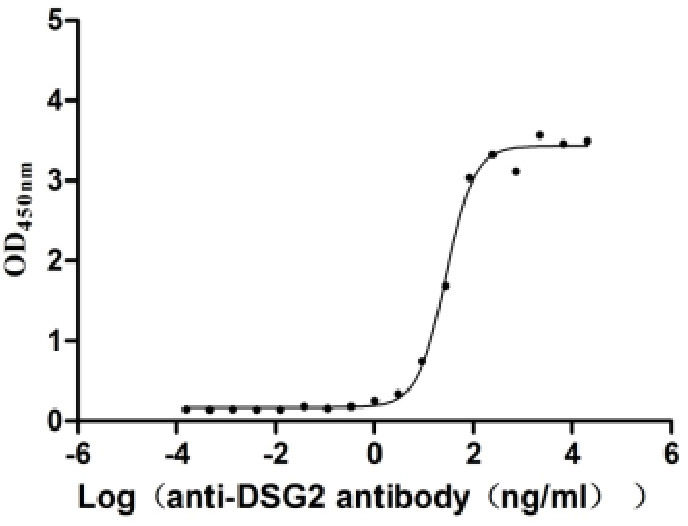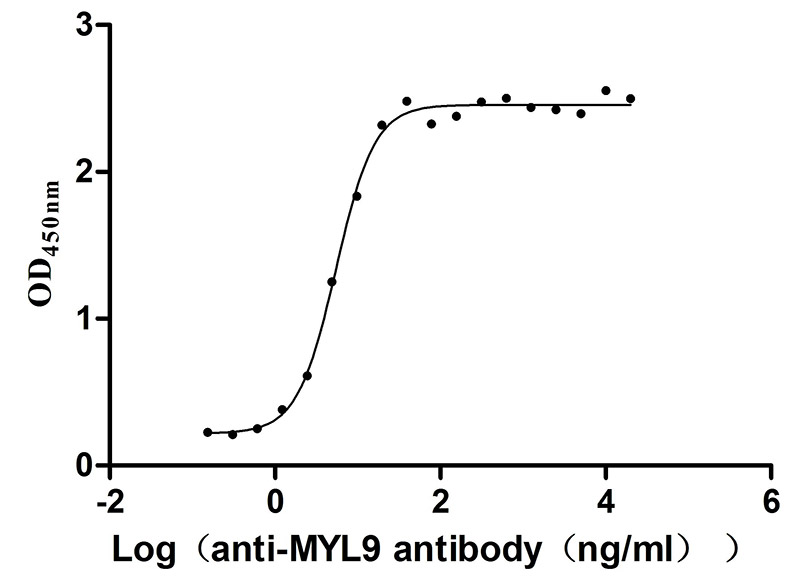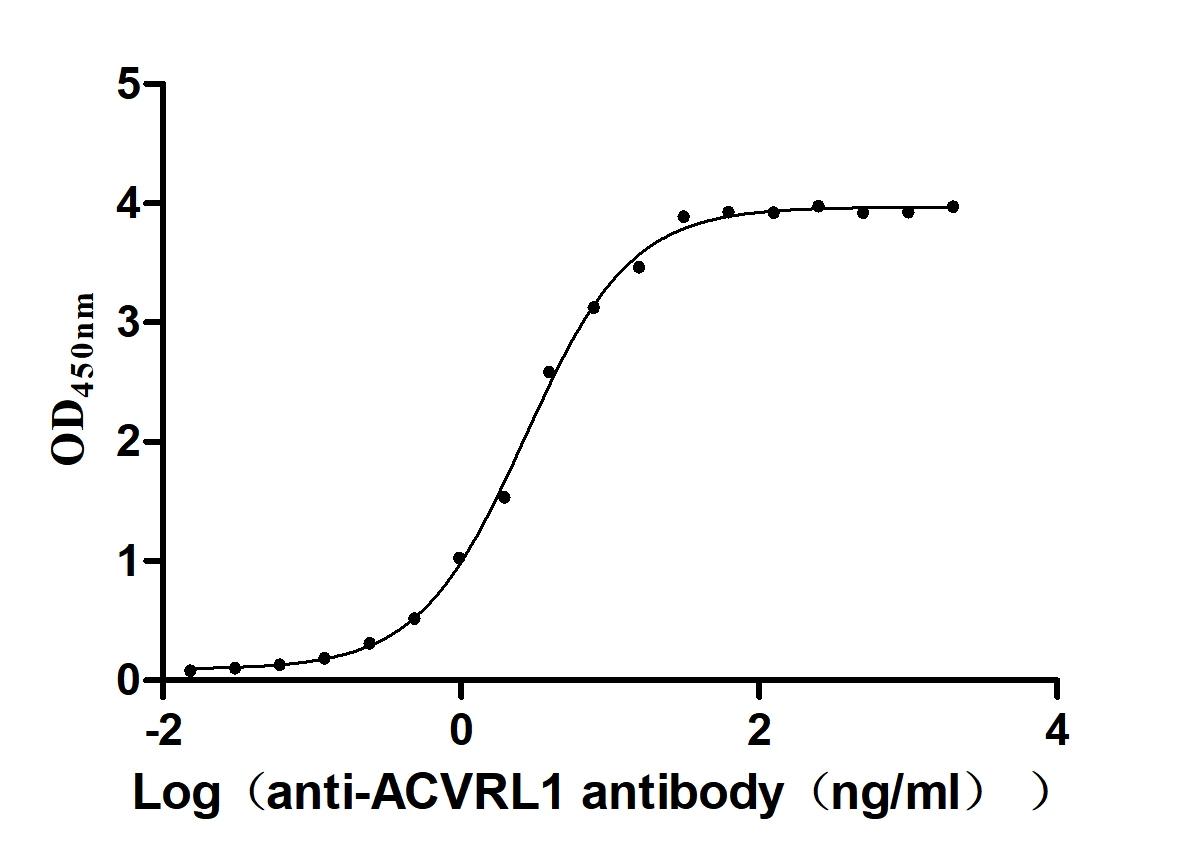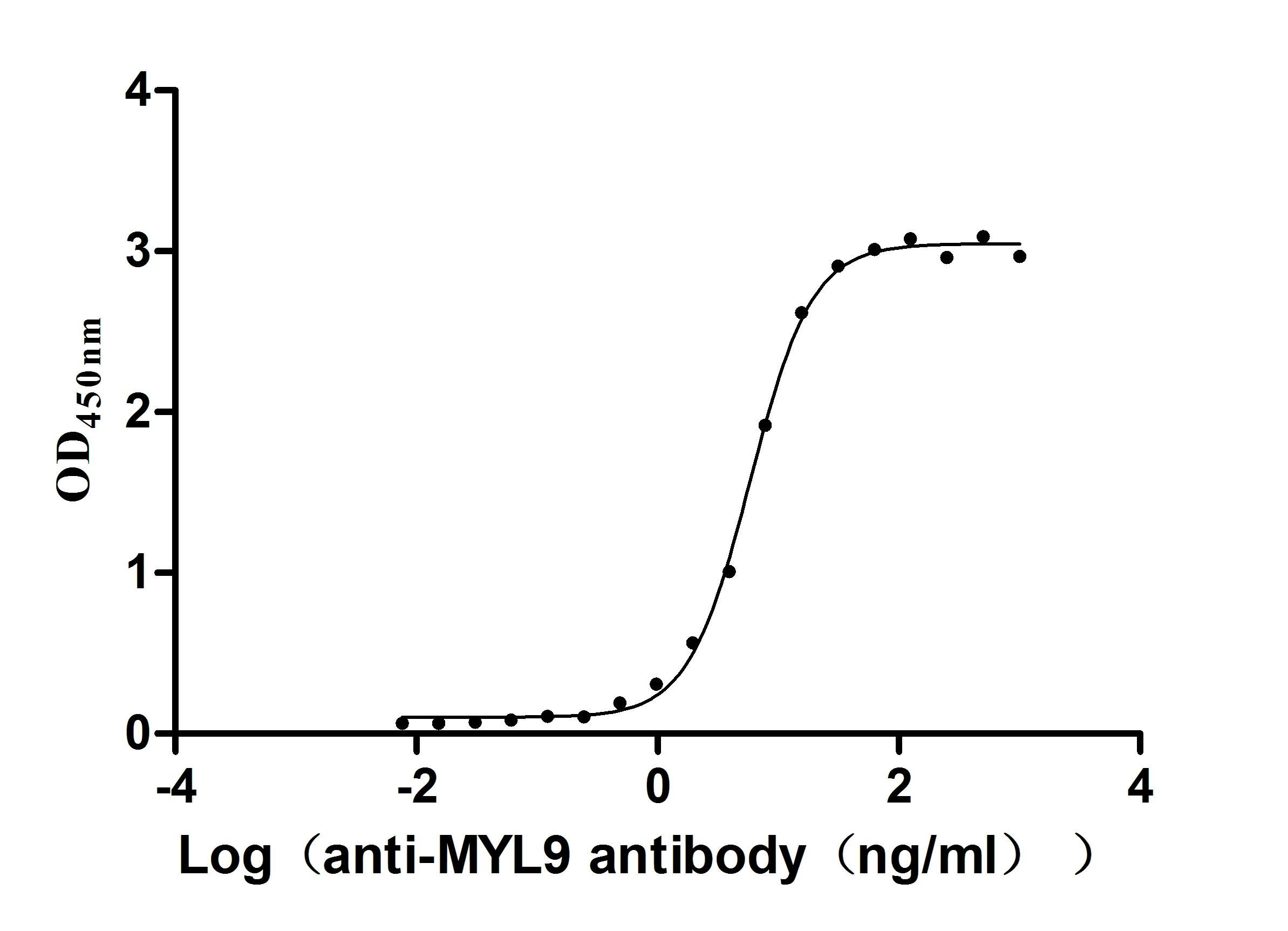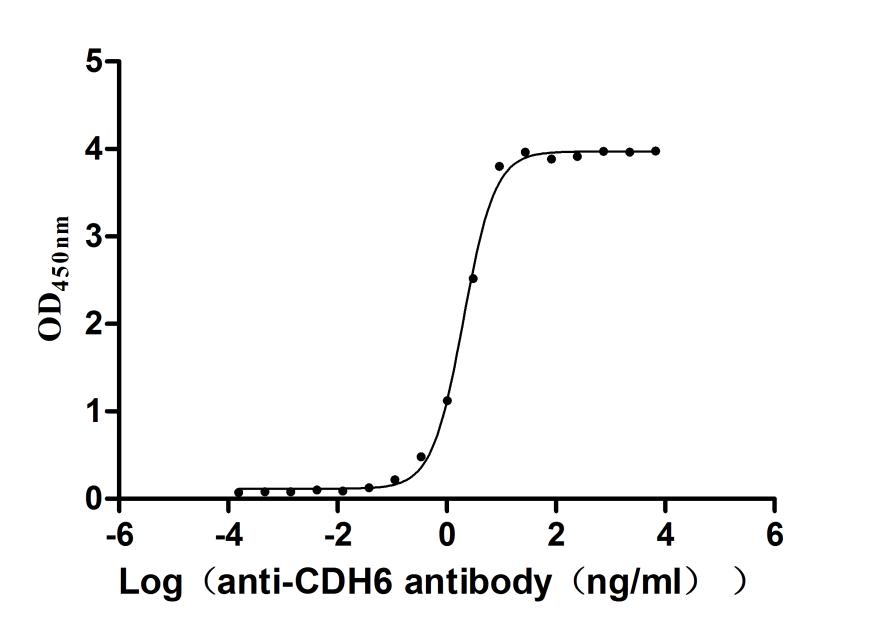Recombinant Drosophila melanogaster Period circadian protein (per), partial
-
中文名稱:黑腹果蠅per重組蛋白
-
貨號(hào):CSB-YP357174DLU
-
規(guī)格:
-
來(lái)源:Yeast
-
其他:
-
中文名稱:黑腹果蠅per重組蛋白
-
貨號(hào):CSB-EP357174DLU
-
規(guī)格:
-
來(lái)源:E.coli
-
其他:
-
中文名稱:黑腹果蠅per重組蛋白
-
貨號(hào):CSB-EP357174DLU-B
-
規(guī)格:
-
來(lái)源:E.coli
-
共軛:Avi-tag Biotinylated
E. coli biotin ligase (BirA) is highly specific in covalently attaching biotin to the 15 amino acid AviTag peptide. This recombinant protein was biotinylated in vivo by AviTag-BirA technology, which method is BriA catalyzes amide linkage between the biotin and the specific lysine of the AviTag.
-
其他:
-
中文名稱:黑腹果蠅per重組蛋白
-
貨號(hào):CSB-BP357174DLU
-
規(guī)格:
-
來(lái)源:Baculovirus
-
其他:
-
中文名稱:黑腹果蠅per重組蛋白
-
貨號(hào):CSB-MP357174DLU
-
規(guī)格:
-
來(lái)源:Mammalian cell
-
其他:
產(chǎn)品詳情
-
純度:>85% (SDS-PAGE)
-
基因名:per
-
Uniprot No.:
-
別名:per; CG2647; Period circadian protein; Protein clock-6; CLK-6
-
種屬:Drosophila melanogaster (Fruit fly)
-
蛋白長(zhǎng)度:Partial
-
蛋白標(biāo)簽:Tag?type?will?be?determined?during?the?manufacturing?process.
The tag type will be determined during production process. If you have specified tag type, please tell us and we will develop the specified tag preferentially. -
產(chǎn)品提供形式:Lyophilized powder
Note: We will preferentially ship the format that we have in stock, however, if you have any special requirement for the format, please remark your requirement when placing the order, we will prepare according to your demand. -
復(fù)溶:We recommend that this vial be briefly centrifuged prior to opening to bring the contents to the bottom. Please reconstitute protein in deionized sterile water to a concentration of 0.1-1.0 mg/mL.We recommend to add 5-50% of glycerol (final concentration) and aliquot for long-term storage at -20℃/-80℃. Our default final concentration of glycerol is 50%. Customers could use it as reference.
-
儲(chǔ)存條件:Store at -20°C/-80°C upon receipt, aliquoting is necessary for mutiple use. Avoid repeated freeze-thaw cycles.
-
保質(zhì)期:The shelf life is related to many factors, storage state, buffer ingredients, storage temperature and the stability of the protein itself.
Generally, the shelf life of liquid form is 6 months at -20°C/-80°C. The shelf life of lyophilized form is 12 months at -20°C/-80°C. -
貨期:Delivery time may differ from different purchasing way or location, please kindly consult your local distributors for specific delivery time.Note: All of our proteins are default shipped with normal blue ice packs, if you request to ship with dry ice, please communicate with us in advance and extra fees will be charged.
-
注意事項(xiàng):Repeated freezing and thawing is not recommended. Store working aliquots at 4°C for up to one week.
-
Datasheet :Please contact us to get it.
靶點(diǎn)詳情
-
功能:Essential for biological clock functions. Determines the period length of circadian and ultradian rhythms; an increase in PER dosage leads to shortened circadian rhythms and a decrease leads to lengthened circadian rhythms. Essential for the circadian rhythmicity of locomotor activity, eclosion behavior, and for the rhythmic component of the male courtship song that originates in the thoracic nervous system. The biological cycle depends on the rhythmic formation and nuclear localization of the TIM-PER complex. Light induces the degradation of TIM, which promotes elimination of PER. Nuclear activity of the heterodimer coordinatively regulates PER and TIM transcription through a negative feedback loop. Behaves as a negative element in circadian transcriptional loop. Does not appear to bind DNA, suggesting indirect transcriptional inhibition. Required for binding of cwo to the E box regions in the promoters of target genes of the transcriptional activator Clock, probably by binding to Clock-cycle heterodimers, reducing their affinity for E box binding and allowing cwo to bind instead.
-
基因功能參考文獻(xiàn):
- Results provide molecular evidence that calcineurin-mediated suppression of the proteasomal degradation of PER and TIM proteins is involved in clock regulation. PMID: 29724861
- Unambiguous manual logging of pulses from Stern's primary song records using his software platform FlySongSegmenter reveals per-dependent song rhythms with mean period values close to those published in previous studies. PMID: 28174268
- This time-of-day information requires a functional circadian clock as per01 mutant flies are unable to perform even after added periods of starvation before the training. PMID: 28620079
- Compared to the wild type, both per mutants showed reduced longevity and decreased startle-induced locomotion in aging flies, while spontaneous locomotor activity was not impaired. The per(01) phenotypes were generally less severe than those of per(T), suggesting that chronic jet lag is more detrimental to aging than arrhythmicity in Drosophila. PMID: 27639775
- dper codon usage is important for circadian clock function PMID: 27542830
- Here we demonstrate that the transcription factor CLOCKWORK ORANGE (CWO) antagonizes CLK-CYC E-box binding, thus enhancing the removal of CLK-CYC from E-boxes to maintain transcriptional repression. This process requires PER, which suggests that PER-TIM and CWO cooperate to maintain a transcriptionally repressed state by removing CLK-CYC from E-boxes PMID: 27814361
- study of behaviorally arrhythmic Drosophila circadian period mutants identified a novel link between nutrient intake and tolerance of infection with B. cepacia PMID: 26748856
- Mutant flies in which phosphorylation at Ser826/Ser828 of the period clock protein is blocked manifest behavioral rhythms with periods slightly longer than 1 h and with altered temperature compensation properties. PMID: 26711257
- E75 and UNF bind to PER regulatory sequences and act together to enhance the CLK/CYC-mediated transcription of the PER gene. PMID: 26004759
- oscillations of per and tim mRNAs and their posttranscriptional regulation; observed significant differences in molecular cycling under laboratory and natural conditions; robust per mRNA cycling from fly heads is limited to the summers; tim RNA cycling is observed throughout the year PMID: 25994101
- Effects of different per translational kinetics on the dynamics of a core circadian clock model. PMID: 25607544
- The molecular circadian cycle in adult heads exhibited parallel responses to temperature-mediated resetting at the levels of per transcript, tim transcript and TIM protein. PMID: 25165772
- Dod associates preferentially with phosphorylated species of PER, which delays the phosphorylation-dependent degradation of PER. PMID: 25998391
- on warm days the inefficient splicing of the dmpi8 intron (in per gene) triggers an increase in quiescence by decreasing sensory-mediated arousal, ensuring flies minimize being active during the hot midday, despite the presence of light in the environment PMID: 25325457
- This is supported by attenuated interaction of IMPa1 with TIM carrying a mutation previously shown to prevent nuclear entry of TIM and PER. PMID: 25674790
- The PDF-mediated increase in cAMP might lengthen circadian period by directly enhancing PER stability. PMID: 24707054
- Together these data establish functional significance for a new domain of PER, demonstrate that cooperativity between phosphorylation sites maintains PER function. PMID: 24086144
- PER degradation dictates qualitative as well as quantitative features of light-mediated phase-resetting PMID: 23735496
- ATX2 coordinates an active translation complex important for PER expression and circadian rhythms. PMID: 23687047
- this work uncovers a role for ATX2 in circadian timing and reveals that this protein functions as an activator of PER translation in circadian neurons. PMID: 23687048
- Natural variations in the per gene can modulate the splicing efficiency of the dmpi8 intron and the daily distribution of activity. PMID: 23152918
- The results of this study suggested that per may mediate the enhancement of long-term courtship memory following Fan-shaped body neurons activation and sleep induction PMID: 23154928
- Data indicate that the period (PER) loss-of-function mutant flies were arrhythmic in laboratory condition but displayed weak rhythmic emergence under seminatural condition. PMID: 22855572
- In prothoracic gland cells associated with the CNS, however, per transcription is markedly amplified following 12-h light exposure, resulting in the manifestation of day-night rhythms in nuclear PER immunostaining levels and spontaneous Ca2+ spiking. PMID: 22713751
- This study demonistrated that combined a null mutation in the clock gene period (per(01)) that abolishes circadian rhythms, with a hypomorphic mutation in the (sni(1)), which displays oxidative stress induced neurodegeneration. PMID: 22227001
- A key temporal delay in the circadian cycle of Drosophila is mediated by a nuclear localization signal in the timeless protein. PMID: 21515571
- kinetics of PER degradation with DBT(S) in cell culture resembles that with wild-type DBT and posits that, in flies DBT(S) likely does not modulate the clock by simply affecting PER degradation kinetics PMID: 21659538
- CTRIP destabilizes CLK protein in a PER-independent manner and helps degradation of phosphorylated PER and TIM in the morning PMID: 21525955
- Study shows that the per-short domain functions as a phospho-cluster that delays DBT-mediated phosphorylation at the SLIMB recognition site on dPER, providing insight into how Per phosphorylation contributes to circadian timing mechanisms. PMID: 21514639
- A major transformation in the number and types of cells that express period and timeless takes place between embryonic and larval life. PMID: 20558325
- dperiod period clock does not provoke the daily hyperphosphorylation of dCLOCK, indicating that direct interactions between dperiod period clock and dCLOCK are necessary for the dCLOCK phosphorylation PMID: 20980603
- The expression of per gene declines in old wild type flies, suggesting that the circadian regulatory network becomes impaired with age. PMID: 20157575
- PER is recruited to circadian promoters, which leads to the nighttime decrease of CLK/CYC activity PMID: 20159956
- decreased number of eggs laid and a greater rate of unfertilized eggs. Male contribution to this phenotype was demonstrated by a decrease in reproductive capacity among per(0) and tim(0) males mated with wild-type females. PMID: 11854509
- Stress response genes protect against lethal effects of sleep deprivation in Drosophila PMID: 12015603
- period regulates basal and light-regulated gene expression to a very broad extent. PMID: 12089325
- The F-box protein slimb controls the levels of clock proteins period and timeless PMID: 12432393
- Role for Slimb in the degradation of Drosophila Period protein phosphorylated by Doubletime PMID: 12442174
- transgenic flies carrying the natural per genes from two Drosophila species show that per has the potential to provide permissive conditions for speciation, by affecting mate choice through a mechanism involving species-specific timing of mating behavior PMID: 12546788
- CK2beta is localized within clock neurons and the clock proteins Period (Per) and Timeless (Tim) accumulate to abnormally high levels in the Andante mutant, suggesting a function for CK2-dependent phosphorylation in the molecular oscillator PMID: 12563262
- Clock misexpression in naive brain regions induces circadian gene expression. This includes major components of the pacemaker program, as Clock also activates the rhythmic expression of cryptochrome, a gene that CLOCK normally represses. PMID: 12809606
- Data demonstrate that period (per) and timeless (tim) are involved in a novel noncircadian function in the ovary, and suggest that per and tim are regulated differently in follicle cells than in clock cells. PMID: 14667147
- Drosophila PER transcriptional repressor activity is potentiated by doubletime and CKII kinases PMID: 14759367
- posttranslational mechanisms that drive cycling of PER require the rhythmic expression of PP2A (wdb and tws) PMID: 14980226
- Results identify a novel nonphotic role for phospholipase C (no-receptor-potential-A [norpA]) in the temperature regulation of period gene splicing. PMID: 15060157
- per mutants are defective in long-term memory formation PMID: 15522971
- crystal structure of a PERIOD fragment comprising two tandemly organized PAS (PER-ARNT-SIM) domains (PAS-A and PAS-B) and two additional C-terminal alpha helices (alphaE and alphaF) PMID: 15629718
- Cryptochrome has a role in circadian rhythmicity with the arrhythmic period gene in Drosophila PMID: 16361445
- PER-dependent rhythms in CLK phosphorylation control rhythms in E-box-dependent transcription and CLK stability, thus linking PER and CLK function during the circadian cycle PMID: 16543224
- These findings indicate that the binding of dPER to CLK is not sufficient for transcriptional inhibition, implicating a more indirect mode of action whereby dPER acts as a molecular bridge to "deliver" DBT and/or other factors. PMID: 17452449
顯示更多
收起更多
-
亞細(xì)胞定位:Nucleus. Cytoplasm, perinuclear region. Note=Nuclear at specific periods of the day. First accumulates in the perinuclear region about one hour before translocation into the nucleus. Interaction with Tim is required for nuclear localization.
-
組織特異性:Expressed in neural tissues and in several nonneural tissues of the abdomen. Malpighian tubules contain a circadian pacemaker that functions independently of the brain. Expression oscillates in all tissues studied except for the ovary. PER-A isoforms are
-
數(shù)據(jù)庫(kù)鏈接:
Most popular with customers
-
Recombinant Human Epithelial discoidin domain-containing receptor 1 (DDR1), partial (Active)
Express system: Mammalian cell
Species: Homo sapiens (Human)
-
Recombinant Human Desmoglein-2 (DSG2), partial (Active)
Express system: Mammalian cell
Species: Homo sapiens (Human)
-
Recombinant Human Myosin regulatory light polypeptide 9 (MYL9) (Active)
Express system: Yeast
Species: Homo sapiens (Human)
-
Recombinant Human Serine/threonine-protein kinase receptor R3 (ACVRL1), partial (Active)
Express system: Baculovirus
Species: Homo sapiens (Human)
-
Recombinant Human Myosin regulatory light chain 12A (MYL12A) (Active)
Express system: E.coli
Species: Homo sapiens (Human)
-
Recombinant Mouse Cadherin-6(Cdh6),partial (Active)
Express system: Mammalian cell
Species: Mus musculus (Mouse)
-
Recombinant Human Mucin-13(MUC13),partial (Active)
Express system: yeast
Species: Homo sapiens (Human)



